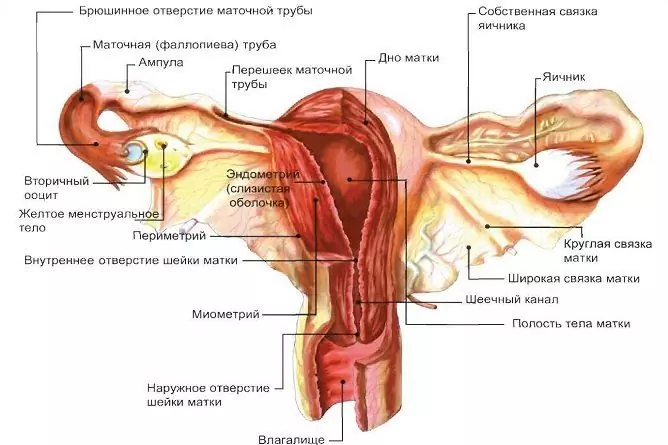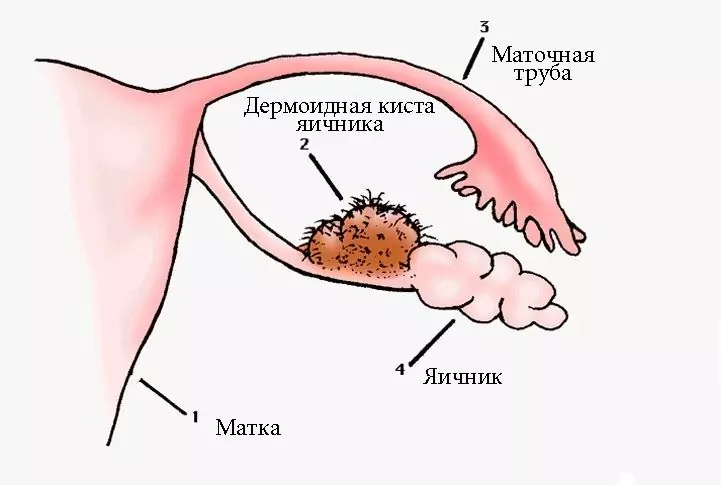- Author Rachel Wainwright [email protected].
- Public 2023-12-15 07:39.
- Last modified 2025-11-02 20:14.
Functional ovarian cyst
The content of the article:
-
Formation mechanism
- Brief physiology of the menstrual cycle
- Types and causes of education
- Symptoms
- Diagnostics
- Treatment of a functional ovarian cyst
- Complications and prognosis
- Prevention
- Video
A functional ovarian cyst is a benign neoplasm, the cavity of which is filled with fluid contents. Most often they occur in women of reproductive age due to various disorders of menstrual function.

Functional ovarian cysts form as a result of malfunctioning of the reproductive system
Formation mechanism
Brief physiology of the menstrual cycle
During the menstrual cycle, there are three phases:
- Follicular. Begins from the first day of your period. At this time, under the action of folliculotropin, one or more follicles grow and mature, inside which the eggs are located.
- Ovulation. Under the influence of the release of luteinizing hormone, the dominant follicle (graaf vesicle) ruptures, and the egg cell enters the abdominal cavity, from where it then enters the lumen of the fallopian tubes.
- Secretory (proliferative). At the site of the bursting follicle, a temporary endocrine gland begins to form - the corpus luteum. Its main function is the synthesis of progesterone, a hormone responsible for preparing a woman's body for a possible pregnancy. If pregnancy has not occurred, then after 10-12 days the corpus luteum undergoes regression and the woman experiences rejection of the inner layer of the uterus (endometrium), which is manifested by menstrual bleeding.
Types and causes of education
Various hormonal imbalances in the hypothalamus-pituitary-ovarian system are accompanied by menstrual dysfunction and often provoke the formation of functional cystic formations, which include:
| View | Reason for development |
| Follicular cyst | They usually occur in young women as a result of non-ovulation. The dominant follicle does not rupture, and it continues to grow. In its cavity, fluid gradually accumulates, which leads to the formation of a cystic formation. Normally, ovulation occurs on the 11-14th day of the menstrual cycle when the size of the dominant follicle is 17-23 mm. Follicular ovarian cyst can reach a diameter of 8-15 cm. Quite often, this form of the disease occurs under the influence of physical or psychoemotional stress, abortion, inflammatory diseases of the genital area (non-specific and specific), ovarian hyperstimulation. Also, the cause of the pathology can be the uncontrolled intake of oral contraceptives. |
| Corpus luteum cyst |
Formed at the site of the corpus luteum. The reasons for its formation are currently not precisely established. It is assumed that a violation of the blood supply to the corpus luteum leads to the accumulation of hemorrhagic or serous fluid in its tissue. Such neoplasms reach 6-8 cm in diameter (normally the size of the corpus luteum itself is 17-25 mm). According to statistics, the disease occurs in 2-5% of women of reproductive age. |
Symptoms
Symptoms of functional ovarian formations are usually very weak or not expressed at all, therefore they are usually detected only when ultrasound examination of the pelvic organs is performed.
Sometimes the disease is accompanied by the appearance of a slight soreness in the lower abdomen, more pronounced from the side of the tumor localization, that is, with a functional cyst of the right ovary, pain and discomfort will be more pronounced in the right lower quadrant of the abdomen, and with a functional cyst of the left ovary, respectively, in the left.
A number of patients may experience various menstrual irregularities:
- irregularity;
- long duration and profusion of menstrual bleeding;
- the appearance of spotting bleeding in the intermenstrual period.
Diagnostics
Diagnosis of functional ovarian formations is based on data:
- Vaginal-abdominal examination. When it is carried out, the gynecologist palpates a small, painless, mobile, rounded tumor located on the left or right side of the body of the uterus. It has a smooth surface and a tight-elastic consistency.
- Ultrasound of the pelvic organs. On scanning, a cyst is defined as a small, unicameral formation with anechoic contents. To obtain the clearest picture, the doctor advises the patient to fill the bladder by drinking 3-4 glasses of liquid before conducting the study (with transvaginal ultrasound, the bladder, on the contrary, must be emptied).
- Laparoscopy. It is carried out to clarify the diagnosis in unclear cases.
Treatment of a functional ovarian cyst
Patients with small functional ovarian formations and in the absence of clinical manifestations are shown dynamic observation, including examinations by a gynecologist and repeated ultrasound.
In some cases, the doctor may prescribe conservative treatment, which includes the following methods:
- drug treatment (non-steroidal anti-inflammatory drugs, oral contraceptives);
- balneotherapy (vaginal irrigation, medicinal baths);
- physiotherapy (magnetotherapy, phonophoresis, electrophoresis, laser therapy).
For the period of treatment, a woman is advised to avoid significant physical exertion and limit sexual activity, as this reduces the risk of complications.
Indications for surgical intervention are:
- lack of regression of cystic formation within 2-3 menstrual cycles;
- significant size of the cyst (over 8 cm);
- the development of complications.
Elective surgery is usually performed by the laparoscopic method and consists in peeling the walls of the cystic formation, followed by suturing the cavity. With the development of complications, laparotomy is performed with resection or complete removal of the ovary.
Complications and prognosis
The prognosis for functional ovarian cysts is generally favorable. In most cases, functional ovarian cysts persist in patients for several menstrual cycles, and then independently regress. They never become malignant, that is, they do not degenerate into a malignant tumor.
With a significant size of cystic neoplasm, there is a risk of developing the following complications:
- rupture of the capsule;
- twist of the leg;
- ovarian apoplexy;
- necrosis of ovarian tissue.
Any of these complications is clinically manifested by the development of a symptom complex of an acute abdomen, the signs of which are:
- the sudden onset of severe pain in the lower abdomen that quickly spreads throughout the abdomen;
- nausea, repeated vomiting;
- delay in passing gas and stool;
- pallor of the skin;
- tachycardia;
- lowering blood pressure;
- rapidly growing weakness;
- dizziness.
With the development of complications of the follicular cyst, the patient is subject to urgent hospitalization in the department of gynecology or general surgery. She is shown to carry out emergency surgery.

Most functional cysts do not require treatment, dynamic monitoring of them using ultrasound is sufficient
Prevention
To prevent the occurrence of functional ovarian cysts, it is necessary:
- Correct any hormonal imbalance in the hypothalamus-pituitary-ovary system.
- Timely identify and actively treat inflammatory diseases of the reproductive system.
Pregnant women with functional ovarian cysts should be closely monitored by an obstetrician-gynecologist. They regularly undergo repeated ultrasound examinations in order to track the growth and changes in the existing ovarian formations.
Video
We offer for viewing a video on the topic of the article.

Elena Minkina Doctor anesthesiologist-resuscitator About the author
Education: graduated from the Tashkent State Medical Institute, specializing in general medicine in 1991. Repeatedly passed refresher courses.
Work experience: anesthesiologist-resuscitator of the city maternity complex, resuscitator of the hemodialysis department.
The information is generalized and provided for informational purposes only. At the first sign of illness, see your doctor. Self-medication is hazardous to health!






